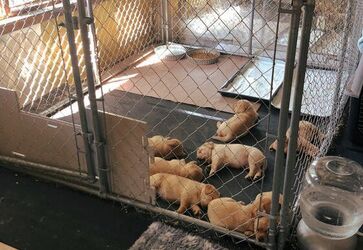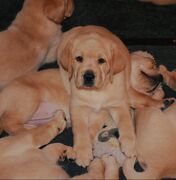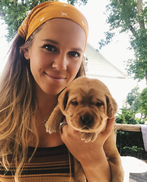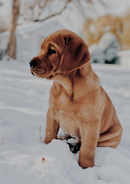It's all in how we raise them!
|
Socialization and enrichment begin the second the puppies are born. For the first three weeks of life, we do early neurological stimulation exercises with each pup every day. Read about the benefits of early neurological stimulation here. They are carefully handled several times per day, and their health is closely monitored. As the weeks go by, they are gradually exposed to age-appropriate situations to encourage them to build confidence, adaptability, and trust in humans.
All of our dogs live in the house with us, and the puppies are no exception! We have an enclosure in our living room where the puppies live. We put rubber flooring down and scrub it clean daily with mild nontoxic soap and hot water. We are very careful about what products and cleaners are used around the puppies as are they are in their early growth phases. We are firm believers that "a little dirt never hurts" - our puppies get plenty of outdoor exposure from a young age, to allow them to build healthy immune systems. At around 3 weeks old, the puppies begin to use a "potty box" to do their business. We also take them out to the yard for bathroom breaks/"recess" throughout the day. |
Puppies will receive age-appropriate vaccinations and de-worming while in our care, as well as a thorough veterinary exam between 6-7 weeks old to make sure each puppy is healthy and ready to take on the world! We guarantee each puppy free from any defects that may affect their life as a pet. A detailed veterinary history for each puppy will be included in the packet given at the time of pickup. We also provide official health papers for any puppies that need to fly on a plane or cross state lines.
Once the pups receive their first round of vaccinations, they are able to begin exploring the outside world. We do a few "outings" during weeks 7 through 9 so the puppies get used to traveling in the car to new places. They get several positive interactions with kids, adults, strangers, dogs, and other animals during their time with us.
At the end of the day, each pup gets a solo session with us and the older dogs, where they are encouraged to hang out away from their litter mates. They grow to love their alone time with the humans, and it's fun to watch them gain confidence out by themselves. As they approach 7-8 weeks, we begin to add in a casual introduction to crate training. All this to hopefully smooth the transition to life with their new families!
At the end of the day, each pup gets a solo session with us and the older dogs, where they are encouraged to hang out away from their litter mates. They grow to love their alone time with the humans, and it's fun to watch them gain confidence out by themselves. As they approach 7-8 weeks, we begin to add in a casual introduction to crate training. All this to hopefully smooth the transition to life with their new families!
If you are on our waiting list, you are welcome to schedule a visit to meet the puppies as soon as they vaccinated. Please do not show up without an appointment. This is our home and we try to maintain strict biosecurity measures when we have puppies around. Thank you for understanding!
The Puppy Selection Process
- When the puppies are approximately 2 weeks old, families on the waiting list will be notified if they have been selected to receive a puppy from the litter.
- When the puppies are approximately 7-8 weeks old, families will be matched with a specific puppy from that litter. Each puppy is an individual, so we carefully place them with people that match their characteristics. Lifestyle, energy level, future plans, and physical preferences are all taken into consideration when we make puppy placements.
- Please understand that we do NOT place puppies based on "redness" or "darkness". If you are on the list wanting a "fox red" puppy, just know that there are a variety of shades, and our "red" puppies do not tend to be very dark. We will always choose health, temperament, structure, and genetic diversity over color.
- Puppies will leave for their new homes between 8-9 weeks old. This gives us time to select show prospects and make travel arrangements. Most importantly, the puppies gain valuable social skills by wrestling and interacting with their littermates.
- It is required to meet in person to pick up your puppy. You can come to our farm in western Iowa, or we can meet you at a nearby airport (Omaha, NE) so you can travel with the puppy in-cabin in a carry-on sized crate. If traveling by air, it is the buyer's responsibility to arrange the flight and ensure the puppy falls into the age & weight range allowing them to fly as carry-on with the airline they have chosen. We do not ship puppies via air or ground cargo.
To prevent irresponsible dog breeding, all of our puppies are sold on AKC Limited Registration. This means that the dog is AKC-registered, but may not be bred at any point in its lifetime. Dogs on Limited Registration can participate in the majority of AKC events such as obedience, rally, hunt tests, agility, nose work, the CGC program, and many more! They are only ineligible for the events intended for breeding stock, such as conformation. Puppy families will sign a contract stating they will spay/neuter their dogs by the time they are 3 years of age. We strongly encourage puppy families to keep their dogs intact until they are fully mature (around 18 months), to prevent health issues later in life.
And most importantly: we are here to provide LIFETIME support for our puppies! More often than not, puppy families become like family to us. We hope they feel comfortable coming to us for any question or concern they have regarding their puppy, at any time. I might not have every answer, but I will go to great lengths to help in any way that I can. If one of our puppies must be rehomed, we are happy to take the dog back into our care at any point in its lifetime, no questions asked.
Health guarantee
We have a 3-year genetic health guarantee on all of our puppies. Click here for more info.
HELPFUL LINKS FOR OUR PUPPY FAMILIES
Here is our "puppy packet" which contains helpful hints and recommendations about puppy exercise, nutrition, training, and more:
And here is a list of products you might want to buy to prepare for your new puppy:
Frequently Asked Questions
Are your Labs English or American style?
We proudly raise well-bred, AKC breed standard Labrador Retrievers. In my opinion, "English Lab" has become a backyard breeder term for an overly large, purposeless Lab with a head reminiscent of a Rottweiler. Instead of that, we strive for a beautiful, functional dog who is structurally and temperamentally sound, with those characteristic Labrador features such as the kind eyes, soft expression, strong front and rear, substantial bone and paws, dense water-resistant double coat, and distinctive otter tail. So long story short, we don't feel our Labs fall into either the "English" or "American" categories.
What is a fox red Lab?
Fox red is a term for a shade of very dark yellow Lab. Yellow Labs come in a range of colors from dark red to almost white, all of which have the same basic color genotype. Believe it or not, fox red is actually the original "shade" of Yellow (think about Old Yeller!). The shade became more rare in the 90s/00s, when the "white" shade of yellow became a fad. A few great breeders preserved the fox red shade in their lines here in the USA such as Dr. Pam Doubek (Penara Labs), Judy McCormick (Keepsake Labradors), and Sally Kelly (Kelleygreen Labradors). All of the fox red Labradors of today trace back to a those select few dogs. Read more about fox red history here: penara.com/fox-red-history.html
Is there a difference in temperament or trainability between males & females?
In this breed, there should be no difference in temperament or trainability between the males and females. Structural differences are the main things you will notice (males tend to get bigger & blockier, and females tend to be a little bit smaller and more feminine). Contrary to popular belief, both sexes will hump things (especially if left intact), but this behavior is easily mitigated with proper training and socialization.
Do you remove dew claws?
Nope. There is evidence that removal of dewclaws in puppies is associated with carpal arthritis later in life. Furthermore, dogs use their dewclaws for gripping and climbing (watch this video if you don't believe me!). Dewclaw removal has become a thing of the past among many show and field breeders. As long as the dewclaws are routinely trimmed along with the other claws, they are no more likely to be injured than the four other claws on a dog's paw. So we leave them how God intended!
We proudly raise well-bred, AKC breed standard Labrador Retrievers. In my opinion, "English Lab" has become a backyard breeder term for an overly large, purposeless Lab with a head reminiscent of a Rottweiler. Instead of that, we strive for a beautiful, functional dog who is structurally and temperamentally sound, with those characteristic Labrador features such as the kind eyes, soft expression, strong front and rear, substantial bone and paws, dense water-resistant double coat, and distinctive otter tail. So long story short, we don't feel our Labs fall into either the "English" or "American" categories.
What is a fox red Lab?
Fox red is a term for a shade of very dark yellow Lab. Yellow Labs come in a range of colors from dark red to almost white, all of which have the same basic color genotype. Believe it or not, fox red is actually the original "shade" of Yellow (think about Old Yeller!). The shade became more rare in the 90s/00s, when the "white" shade of yellow became a fad. A few great breeders preserved the fox red shade in their lines here in the USA such as Dr. Pam Doubek (Penara Labs), Judy McCormick (Keepsake Labradors), and Sally Kelly (Kelleygreen Labradors). All of the fox red Labradors of today trace back to a those select few dogs. Read more about fox red history here: penara.com/fox-red-history.html
Is there a difference in temperament or trainability between males & females?
In this breed, there should be no difference in temperament or trainability between the males and females. Structural differences are the main things you will notice (males tend to get bigger & blockier, and females tend to be a little bit smaller and more feminine). Contrary to popular belief, both sexes will hump things (especially if left intact), but this behavior is easily mitigated with proper training and socialization.
Do you remove dew claws?
Nope. There is evidence that removal of dewclaws in puppies is associated with carpal arthritis later in life. Furthermore, dogs use their dewclaws for gripping and climbing (watch this video if you don't believe me!). Dewclaw removal has become a thing of the past among many show and field breeders. As long as the dewclaws are routinely trimmed along with the other claws, they are no more likely to be injured than the four other claws on a dog's paw. So we leave them how God intended!
Claudia Swanger, DVM 🐾 712-369-0024 🐾 [email protected] 🐾 @FlairCreekLabs
Copyright Flair Creek Labs. All rights reserved.
Copyright Flair Creek Labs. All rights reserved.




